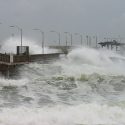Scientists assess shoreline development impact
Every summer, Wisconsites, along with Illini and Hoosiers, pack up their SUVs and head to cottages “up north,” where some 2,500 lakes offer recreation and relaxation. Yet, shoreline development – houses, boat docks, even beaches – could threaten what these vacationers hold so dear.
To understand the ecological effects of lakeshore development on these freshwater ecosystems, UW–Madison has launched an extreme experiment – remove all the woody debris from one lake’s shoreline waters and study what happens.
According to the Wisconsin Department of Natural Resources, housing development in the northern region of the state has soared: Lakes today have about nine times more homes surrounding them than they did in the 1960s.
“When people develop the land around lakes, they tend to simplify the shore along their properties by removing coarse woody debris and aquatic vegetation,” says Greg Sass, a graduate student in zoology at the Center for Limnology who’s working on the project. But this debris and vegetation, Sass notes, often provide a base for algae growth, a perch for birds and a refuge for fish.
So, how does removing the coarse woody debris from the shore waters change the communities living in the lakes, which, in turn, could change human recreation, including fishing? That’s what the UW–Madison researchers hope to discover.
While previous studies have shown that lack of woody debris in the water may reduce fish reproduction, the Wisconsin group’s study will take a broader look at changes in the fish community, including their abundance, diet and growth.
“Our research is intended to help property owners and regulatory agencies understand the ecological consequences and trade-offs that result from the decisions they make,” says James Kitchell, director of the Center for Limnology and primary investigator on the project.
To achieve this goal, the researchers have started their own “development” project: they’ve removed all the coarse woody debris, just as landowners would do, along the shoreline of Little Rock Lake, part of UW–Madison’s Trout Lake Research Station in northern Wisconsin. The lake, closed to the public, is home to large mouth bass, yellow perch, black crappie and rock bass.
Sass and his sturdy helpers have spent the summer removing wood as deep as two meters under the surface or, as Sass more casually explains, “about up to our shoulders.” Most of the wood comes from pines trees, either leftover from logging or blown over, and birch or oak trees, frequently gnawed down by beavers.
Though equipped with a chain saw, Sass, who worked construction as an undergraduate student, admits, “each log is kind of like a puzzle. It takes some time to figure out the best way to get it out of the water.”
About halfway finished with the wood removal effort, Sass already has noticed a change in the lake: “It looks sterile,” he says. “There are no tree tops or logs sticking out of the water. Nothing’s breaking it up. There’s no complexity.” Plus, when Sass now fishes on the lake (for research purposes), most fish are caught in the deeper waters, not near the shore, where they were caught before.
Once all the debris is removed, Sass and Kitchell will study how the removal, and subsequent simplification of the shoreline, influences fish growth, abundance, reproduction and diet. Last summer Sass collected pre-manipulation data (primarily by snorkeling and fishing), and he’ll compare that with data collected over the next two years. Beginning winter 2003, the group will add woody debris to Camp Lake, also in northern Wisconsin.
What they find could influence future lakeshore development: “If people want an immaculate waterfront without logs in the lake, that probably means that fish will grow less well and fishing will be less productive,” says Kitchell. “If they want great fishing, then leaving some or all the logs in the water is a logical choice. How many is just right? We don’t know. We may be able to work on that after we see how much response occurs under the most extreme conditions.”
But, both Kitchell and Sass stress that, while the short-term study will highlight quick responses to wood removal, the long-term outcomes might not be observed for another 10 years.
The wood manipulation project is part of a five-year grant , funded by the National Science Foundation, to study the interface between lakes and humans.


